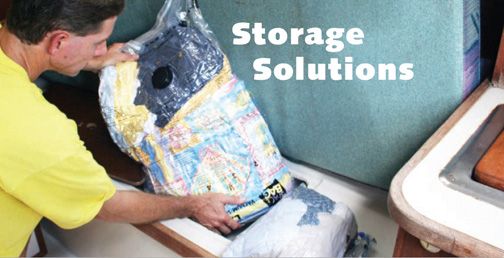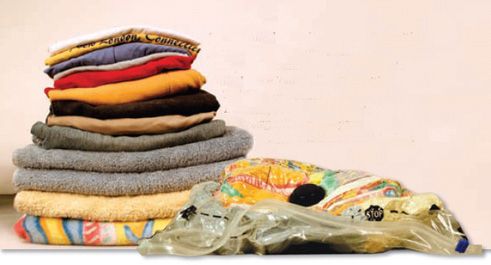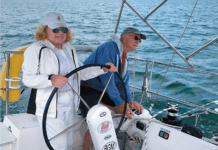Spare clothing, bedding, and all the other things that end up stuffed into sailboat lockers need to be organized and protected from the elements. Our standard solution has been Ziploc bags for books and smaller items and inexpensive zippered plastic bags for clothing, bedding, and larger items. Beyond this, there are two options with more benefits.

Kayaking dry bags are super tough and truly watertight, which is useful, for example, when transporting the clean laundry in the dinghy. In the late 1990s, a new type of vacuum-sealed storage bag was developed and sold under the Space Bag label and other names. With these, the air is expelled from the bag so that it can compress to stow in a much smaller space. The vacuum seal keeps the bags watertight, and keeps out mildew, dust, bugs, and odor.
WHAT WE TESTED
Many outlets sell the bags under a variety of names, but there appear to be two different compression technologies: rolling the air out through valves on the end and sucking the air out with a vacuum cleaner through a one-way valve. We ordered several sizes of each brand tested; when we got the bags, we discovered they were ultimately made by the same company.
CUBE STYLE
You can get large cube stowage bags at most mass merchants. We bought two different sizes at WalMart for $5 each.
These bags are made from medium-weight (9-ounce) vinyl; versions with extra ripstop reinforcing fibers are also available. The bags are moderately puncture-resistant and can be tossed around and sat on without fear.
These bags are water resistant, but in no way waterproof, as leakage will occur through the zipper and seams. Humidity and moisture will also easily seep in. Cedar balls will minimize moth problems without the nasty odor and noxious fumes of mothballs.
The cube shape and three-sided zipper on the top make them the most convenient of the bags tested to fill neatly. These are also the most inexpensive bags.
The bags can be rolled up to save space, but will not compress nearly as much as the vacuum bags. These bags are useful for stowing other bags; they keep things organized. They are best used in conjunction with the vacuum bags.
Bottom Line: If you have lots of stowage space, and you don’t need to protect your storage items from humidity, use these bags. But they are not watertight and will serve best for containing and neatly organizing truly watertight bags.
DRY BAG
DRY bags, often used for kayaking, diving, and other watersports, come in sizes from 10 to 38 liters. Identical bags are sold under different names. We bought an extra-large 32-liter (11 in. x 19 in.) See Bag at a local kayaking store in Seattle, but these bags can also be purchased from marine chandleries and mass merchants.
This bag is made of very heavy, see-through vinyl with a reinforced bottom. It is, by far, the most puncture-resistant of the bags tested. It was impossible to break the material with our paperclip. The cylindrical shape with a relatively narrow mouth made it the most difficult to fill with folded clothing; however, it was completely watertight and quite easy to seal. This bag was also the most expensive.
Bottom Line: This is the bag to take ashore in the dinghy. It will easily shrug off any hard knocks you throw at it and protect your most delicate items including cameras and cell phones. If some air is kept in the bag when it is closed, it will float, and it is completely watertight. But it is both a bit clumsy to stow and expensive for long-term stowage use aboard.

SPACE BAG
We ordered these directly from http://www.spacebag.com/, but you can get them from many other websites and retail outlets. They are also sold under the Coleman brand.
Space Bags come in at least six different sizes. The jumbo size can swallow two bedding sets plus four pillows and is probably a bit too large (35 in. x 48 in.) for boat stowage. The Extra-Large (26 in. x 39 in.) and Large (21 in. x 33 in.) are probably the most useful sizes ($6 each) for major stowage. These are constructed as flat envelopes, and it takes some experimentation to get them filled neatly. Space Bag has introduced an E-Z Load model (29 in. x 26 in.); it has an expandable bottom that makes it easier to fill neatly.
The bags are made of rather thin (2.2 millimeter), bi-axial layers of nylon and polyethylene, which was punctured quite easily by our testers paperclip. The bags come with various precautions: Remove all sharp objects from items prior to packing in bag; avoid bending or creasing the zipper; keep away from heat; and remove sharp rings from fingers before use. This reinforces the idea that the bags are not very robust. They are completely watertight, and they presumably will even keep out mildew, bugs, dust, and odors.
Compressing the contents is a three-step process: (1) Pack with items-be careful not to pack above the marked full line; (2) Seal the opening with the sliding zipper (much like the Ziploc bags zip-pers)-this is the tricky phase as you have to make sure none of the contents get stuck in the zipper, which causes the plastic zipper to easily pop off; (3) Use any vacuum cleaner to suck air out of the one-way valve. You can also roll/press air out the valve, but that does not compress the contents as completely as a vacuuming. Lofty contents like pile jackets or pillows can be compressed down to one-third original size. In our tests, the vacuum seal was still holding after three months. We are told by several long-term users that the seal will typically last for a month or two without any slow leaks. Stowing the bags tightly in the cubes described above will prevent them from taking in much air and decompressing.
Bottom Line: These bags give the best protection from humidity and provide the best space savings capability. To offset that, you will need to be careful not to puncture them. The fussiness of the zipper is a disadvantage, and the durability is questionable. Stowing the plastic zipper pieces separately will keep them from being lost all together. Pending long-term durability results, the Space Bag-especially the E-Z load model-is the best choice for on-board stowage.
PACKMATE
Testers bought the Packmate bags from http://www.qvc.com/, but the packing material suggests they are made by the same company (New West Products) that produces the Space Bags. The Packmates come in many sizes with Jumbo (27 in. x 35 in.) and Large (19 in. x 25 in.) being the most useful for on-board stowage.
The significant differences between these and the Space Bags are the compression method and one-way valves. Packmates are designed to have the air rolled out rather than vacuumed out. This is a slower and fussier process, and it cuts compression by about 10 percent. The Packmate valves are smaller, flatter, and less robust. The construction-bag material and zippers-appears identical to the Space Bags.
Bottom Line: The Packmates are quality bags, but testers prefer the vacuum compression.
CONCLUSIONS
These bags offer stowage options for long-distance sailors and live-aboard cruisers. Each needs to be used in a way consistent with its strengths. We recommend the Space Bags E-Z load model for onboard stowage and the kayaking See Bag for dinghy transportation. We will report back in a year on how they are really holding up.
CONTACTS
SPACE BAG, 800/617-4190, spacebag.com
PACKMATE, 800/432-7517, packmate.com
SEAL LINE GEAR (See bag), 800/531-9531, seallinegear.com





































